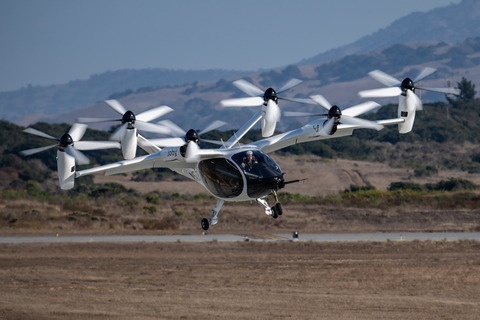Joby Begins Flight Testing with Pilot On Board
- Four Joby pilots have completed flights on board the electric air taxi
-
Flights took place at Joby’s production facility in
Marina, CA - Flying with pilot on board marks critical step on company’s journey to commercial operations

Joby Test Pilot Zach Reeder conducting flight tests onboard the Joby aircraft in
Four members of Joby’s flight test team have now piloted flights on board Joby’s pre-production prototype aircraft, completing a series of initial tests that included free thrustborne hovers and forward transitions to semi-thrustborne flight.
The testing took place at the company’s Pilot Production Facility in
To date, the majority of Joby’s flight testing has been piloted remotely from a ground control station (GCS), using state-of-the-art communications technology and software. This has allowed the company to generate a vast amount of data on the performance of the aircraft across a broad range of flight conditions.
The pilot on board campaign was led by Joby Chief Test Pilot James “Buddy” Denham and was designed to gather data on the aircraft’s handling qualities and pilot control interfaces, supporting the development of the aircraft and laying the groundwork for future “for credit” testing as part of the company’s ongoing certification program with the Federal Aviation Administration (FAA).
“Having helped design and test flight controls for a wide variety of aircraft, including all three variants of the F-35 Joint Strike Fighter, nothing compares to the simplicity and grace of the Joby aircraft,” said Denham. “After completing more than 400 vertical take-offs and landings from the ground, it is a privilege to sit in the cockpit of our aircraft and experience first-hand the ease and intuitive nature of the design that the Joby team has developed.”
During the testing, Joby pilots assessed the ease of conducting a number of tasks and maneuvers that pilots will be required to perform during normal operations, including vertical takeoffs, accelerating and transitioning to forward flight, runway centerline tracking, and decelerating to a vertical landing on a representative landing pad. Evaluation of these mission task elements (MTEs) will support the certification of the Joby aircraft as well as the company’s ongoing work with the Department of Defense.
Denham joined Joby in 2019 after retiring from Naval Air Systems Command where he was an Esteemed Technical Fellow focused on the research, development, test, and evaluation of advanced flight controls and flight dynamics for a wide variety of aircraft. He led the research and development of the Unified Control Concept — a joint
Joby recently announced it will locate its first scaled aircraft manufacturing facility in
About Joby
Joby Aviation, Inc. (NYSE:JOBY) is a
Forward Looking Statements
This press release contains “forward-looking statements” within the meaning of the “safe harbor” provisions of the Private Securities Litigation Reform Act of 1995, including but not limited to, statements regarding the development and performance of our aircraft, the growth of our manufacturing capabilities, our regulatory outlook, progress and timing; our planned operations with the Department of Defense; our business plan, objectives, goals and market opportunity; and our current expectations relating to our business, financial condition, results of operations, prospects, capital needs and growth of our operations. You can identify forward-looking statements by the fact that they do not relate strictly to historical or current facts. These statements may include words such as “anticipate”, “estimate”, “expect”, “project”, “plan”, “intend”, “believe”, “may”, “will”, “should”, “can have”, “likely” and other words and terms of similar meaning in connection with any discussion of the timing or nature of future operating or financial performance or other events. All forward looking statements are subject to risks and uncertainties that may cause actual results to differ materially, including: our ability to launch our aerial ridesharing service and the growth of the urban air mobility market generally; our ability to produce aircraft that meet our performance expectations in the volumes and on the timelines that we project, and our ability to launch our service; the competitive environment in which we operate; our future capital needs; our ability to adequately protect and enforce our intellectual property rights; our ability to effectively respond to evolving regulations and standards relating to our aircraft; our reliance on third-party suppliers and service partners; uncertainties related to our estimates of the size of the market for our service and future revenue opportunities; and other important factors discussed in the section titled “Risk Factors” in our Annual Report on Form 10-K, filed with the Securities and Exchange Commission (the “SEC”) on March 1, 2023, and in future filings and other reports we file with or furnish to the SEC. Any such forward-looking statements represent management’s estimates and beliefs as of the date of this presentation. While we may elect to update such forward-looking statements at some point in the future, we disclaim any obligation to do so, even if subsequent events cause our views to change.
View source version on businesswire.com: https://www.businesswire.com/news/home/20231004810455/en/
Joby Aviation
Investors:
investors@jobyaviation.com
Media:
press@jobyaviation.com
Source: Joby Aviation, Inc.







